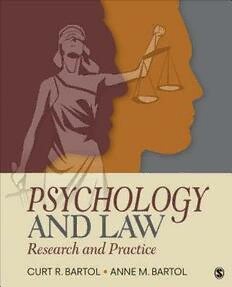
Psychology and Law: Research and Practice PDF
Preview Psychology and Law: Research and Practice
2 To Maddie, because of everything you are and everything you will be. 3 4 Copyright © 2015 by SAGE Publications, Inc. All rights reserved. No part of this book may be reproduced or utilized in any form or by any means, electronic or mechanical, including photocopying, recording, or by any information storage and retrieval system, without permission in writing from the publisher. Printed in the United States of America A catalog record of this book is available from the Library of Congress. ISBN 978-1-4522-5891-1 This book is printed on acid-free paper. 14 15 16 17 18 10 9 8 7 6 5 4 3 2 1 5 FOR INFORMATION: SAGE Publications, Inc. 2455 Teller Road Thousand Oaks, California 91320 E-mail: [email protected] SAGE Publications Ltd. 1 Oliver’s Yard 55 City Road London EC1Y 1SP United Kingdom SAGE Publications India Pvt. Ltd. B 1/I 1 Mohan Cooperative Industrial Area Mathura Road, New Delhi 110 044 India SAGE Publications Asia-Pacific Pte. Ltd. 3 Church Street #10-04 Samsung Hub Singapore 049483 Acquisitions Editor: Jerry Westby Associate Editor: Theresa Accomazzo Editorial Assistant: MaryAnn Vail Production Editor: Libby Larson Copy Editor: Teresa Herlinger Typesetter: C&M Digitals (P) Ltd. Proofreader: Scott Oney Indexer: Sheila Bodell Cover Designer: Janet Kiesel Marketing Manager: Shari Countryman 6 Brief Contents Preface About the Authors 1. Introduction 2. Psychology and the Courts: An Overview 3. The Investigative Process: Detection of Deception, Interrogations, False Confessions, and the Polygraph 4. Competencies and Criminal Responsibility 5. Eyewitness Evidence 6. The Trial Jury 7. Jury and Judicial Decision Making 8. Controversial Evidence in the Courtroom: Profiling, Psychological Autopsies, and Hypnosis 9. Psychology and the Family Court 10. Involuntary Civil Commitment 11. Psychology in Civil Litigation 12. Psychological Assessment and the Law Cases Cited References Glossary Index 7 Detailed Contents Preface About the Authors 1. Introduction Goals and Definitions Definitions of Psychology and Law Psychology and Law: Three Approaches Box 1-1: Work Settings of Psychologists Who Participate in Psychology and Law Activities Psychology in the Law Psychology and the Law Psychology of the Law Box 1-2: Education and Training in Psychology and Law Ways of Knowing and the Methods of Science Courts and the Method of Science The Frye Standard The Daubert Standard Box 1-3: Two Federal Rules of Evidence Regarding Testimony Table 1-1: Factors for Trial Judges to Take Into Account in Deciding Whether to Admit Scientific Evidence in Accordance With the Daubert Case Supreme Court Decisions After Daubert Psychology and the Law: A Challenging Alliance Defining and Classifying Law Content Classifications Civil and Criminal Law Substantive and Procedural Law Classifying by Origin Constitutional Law Statutory Law Administrative Law Psychology and Law: Some Differences Table 1-2: Some Differences Between Psychology and Law Summary and Conclusions Key Concepts 8 2. Psychology and the Courts: An Overview Organization of the Courts Figure 2-1:: Illustration of the Federal Court System Figure 2-2:: View of the Court Structure of Two States Federal Courts Figure 2-3:: Court Structure of Texas State Courts Specialized Courts: Drug and Mental Health Courts Drug Courts Mental Health Courts Box 2-1: Veterans’ Courts The Judicial Process Pretrial Stage Table 2-1: Examples of What May Occur at Four Main Points in the Judicial Process and How Psychologists May Participate The Role of Psychologists Trial Stage The Role of Psychologists Disposition Stage Sentencing Table 2-2: Standards of Proof Applied by Judges and Juries in Trial Courts The Role of Psychologists Appellate Stage The Role of Psychologists Table 2-3: Examples of Amicus Curiae Briefs Recently Filed by the American Psychological Association in Federal and State Appellate Courts The Psychologist as an Expert Witness Expert Certification Legal Standards The Confidentiality Issue Ultimate Issue or Ultimate Opinion Testimony Surviving the Witness Stand Summary and Conclusions Key Concepts 3. The Investigative Process: Detection of Deception, Interrogations, False Confessions, and the Polygraph Legal Background Phrasing the Miranda Warnings The Custody Aspect Box 3-1: Case Study. Police Questioning at School: Where Do We Draw the Line? 9 Comprehending Miranda Warnings Table 3-1: Representative Supreme Court Cases Relating to Self-Incrimination Following Miranda v. Arizona Assessing Miranda Comprehension Detection of Deception Research on Deception Emotional Cues Box 3-2: Detecting Deception in Employment Interviews Behavior Control Cues Cognitive Load The Interrogation Process Confirmation Bias HUMINT Interrogation The Psychology of False Confessions Types or Categories of False Confessions Errors Leading to False Confessions Age, Mental Impairment, and False Confessions Box 3-3: False Confessions and the Seriously Mentally Ill Admissibility of False Confessions in Court Proceedings The Polygraph The Control Question Test Box 3-4: From Burned Tongues to Brain Imaging: A Brief History of “Lie Detecting” Techniques Guilty Knowledge Test Countermeasures Summary and Conclusions Key Concepts 4. Competencies and Criminal Responsibility Box 4-1: Case Study. Competency Not Required for Post-Conviction Habeas Corpus Proceedings: Tibbals v. Carter and Ryan v. Gonzales Competency to Stand Trial Table 4-1: Representative U.S. Supreme Court Cases Relating to Competency Raising the Competency Issue Box 4-2: Is a Defendant’s Primary Language Truly Relevant? Incidence of Competency to Stand Trial Evaluations The Competency Evaluation Process Making the Competency Decision The Incompetent Defendant Is Crime Charged Significant? Do Diagnoses Matter? Table 4-2: Mental Disorders or Diagnoses Commonly Found in Evaluations Submitted 10
